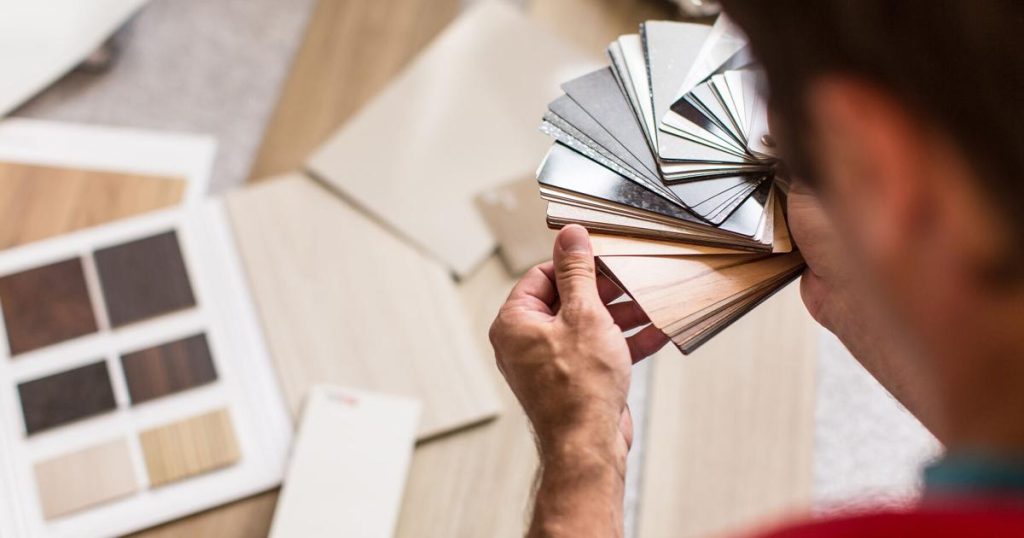Hardwood flooring provides one of the best returns on investment. The National Realtor Association’s 2022 Remodeling Impact Report states that homeowners who install new wood flooring before selling their homes recoup 118 percent of the cost at resale. That means hardwood floors essentially pay for themselves.
But before deciding to take on this home improvement project, consider the cost of installation and materials. Hardwood is expensive, especially if you opt for a more rare wood. There are some steps you can take to save money along the way, but budgeting will be crucial if you want a good ROI.
How much does hardwood flooring cost?
The average cost to install hardwood flooring is between $6 to $25 per square foot, according to Angi. Where the cost goes up is when you include materials. And the cost may be higher — up to $45 per square foot — depending on the material and labor involved in installation.
Materials
Along with your preferences, your home plays a role in what types of wood can or can’t be used. For instance, thinner pieces of wood might warp in areas of your home that are prone to having more moisture. Here are a few general things that will contribute to the cost of the flooring.
— Type of wood. Stronger, more durable types of wood are more expensive. For instance, pine and acacia are less expensive, while walnut and teak are more expensive per square foot.
— Appearance. You’ll also need to look at the type of grain, texture and finishes of the wood planks. The final look will depend on these factors and the length of the boards.
— Thickness of the planks. Certain wood can only be cut to certain thicknesses. The thicker the wood, the more expensive it will be.
— Quality of materials. Will Lau, a residential Realtor based in Southern California, suggests not to go cheap on flooring with the intention of renovating it again later. “Instead, see installing wood floors as an investment that can be enjoyed by you and your family.”
Labor
The other part of hardwood flooring installation cost is labor. Moving furniture, ripping up the old floor and prep work will influence how much installation costs.
— Moving furniture out of the way. If you are only refinishing a single room, you may be able to move the furniture yourself. For a full remodel, you may need to hire professional movers and rent storage space for your furniture.
— Demolishing the existing floor. Labor costs typically include removing the old flooring, but you may be able to do this prep work yourself to save money.
— Preparing the subfloor. You won’t know this cost for sure until you pull out the original flooring, Lau says. The amount of work depends on the size of your home and the condition of your flooring. If your flooring is in less-than-stellar shape, it will cost more.
— Installing new flooring. The cost per square foot can vary and depends on factors such as the square footage and the complexity of the job. Get quotes from multiple contractors to see how much the project may cost you.
How to save on hardwood flooring installation costs
To save on costs, be prepared to do some of the work yourself and put in the time to research costs.
1. Refinish your existing wood floors
This is one of the most cost-effective options, Lau says. However, it’s only an option if you have solid wood floors or certain types of engineered wood. You can’t refinish laminate, which means you may be stuck ripping it out and replacing it with hardwood.
But refinishing does have the highest ROI, according to the Remodeling Impact Report. So if your house already has hardwood and you just want to change the stain, refinishing is the most cost-effective option.
2. Research materials
Since the type of wood you use plays a large role in the cost, research the typical prices for different species, grains, lengths, and thicknesses of wood flooring. Tropical hardwoods will cost more on average, but each type of wood has a wide range of costs depending on quality.
In addition, you should be sure to buy in excess. The lot matters when you need to do touch-ups, so having extra will help avoid mismatched flooring in the future.
3. Decide on engineered versus solid wood
Wood for hardwood flooring comes in two main types: solid and engineered. While solid wood is a single layer of wood, engineered wood is made of several layers of plywood and hardwood.
Engineered wood is more durable and can be more expensive to buy, but it’s less expensive to install and less prone to warping. Solid wood can be less expensive to purchase, but it’s more pricey to install.
4. Remove your furniture
Anything you can do to make it easy for workers will save on costs. Moving and covering your furniture means there’s less the installers need to handle.
You can also compare the cost of having your contractor’s team move your furniture to hiring movers. If you plan on redoing the flooring of your whole house and tackle other projects at the same time, it may be worth the price getting professional movers and a storage space until renovations are done.
5. Demo your old floor yourself
If you have the time and equipment to do it, demolish the existing flooring beforehand, Lau says. Removing the old flooring the tile and laminate yourself can help you save on labor costs. Be careful during the demo, though. You don’t want to mess up the subfloor and cause yourself an additional financial headache.
6. Do it yourself
You might want to do all or part of the job only if you have the experience to install hardwood floors. Otherwise, it might be more costly and time intensive to try to do it yourself only to have to hire someone to fix mistakes later.
How to finance the cost of hardwood flooring
To cover the costs of hardwood flooring, consider taking out a home improvement loan, a home equity loan or a home equity line of credit.
Home improvement loans
Home improvement loans are a type of personal loan meant specifically for projects like hardwood floor installation. They offer fixed rates and are good for covering set costs and are especially useful if you want to avoid using your home as collateral.
If you have already gotten quotes from a contractor and know how much your project will cost, a home improvement loan may be the right option.
Home equity loans
A home equity loan is similar to a home improvement loan. You receive a lump sum and pay back the loan over a set term, usually three to seven years. However, your home is the collateral for the loan. This means you have access to more competitive rates, but if you are unable to repay, you risk losing your home.
Home equity lines of credit
A home equity line of credit (HELOC) also uses your home as collateral. However, it functions similarly to a credit card.
Rather than receive a lump sum, you will have access to funds as you need them and can repay and reborrow as much as you need. The draw period is usually up to 10 years, and they are good for covering unexpected expenses that crop up during big projects like installing hardwood floors.
Next steps
Doing your homework can give you a good idea of how much time and money it will take to purchase the materials and install hardwood flooring. Here’s how you can prepare for your project.
Get plumbing inspected
Lau recommends getting a plumbing inspection to check for issues that could damage your floors. “You want to avoid a pinhole leak from bad pipes that damages the floors,” he says. “Not only the cost of redoing it could be a headache, but also the time and effort in preparation to install and the actual work itself.”
Consider working with a consultant
Lau also recommends considering a consultant who specializes in wood flooring. A consultant can deal with factors you might not have thought of, such as where and what time of day the sun enters the house. It might seem like a minor detail, but natural light could damage the floors.
Make a savings plan
Once you’ve estimated the cost to install hardwood floors in your home, figure out how much you’ll need to save and by when. Many contractors ask for a deposit up front to cover materials, so you might need to have a portion saved up sooner than you anticipate — or secure other financing.
___
©2023 Bankrate online. Visit Bankrate online at bankrate.com. Distributed by Tribune Content Agency, LLC.
Read the full article here














